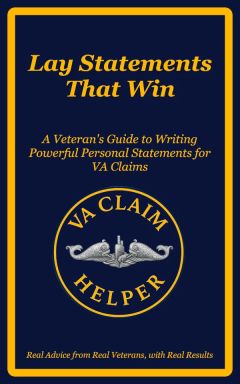Lay Statements That Win
Write Personal Statements That Get Results
$9.99 Kindle edition · Included with Kindle Unlimited
Reader Feedback
Rated 5 out of 5 based on 1 verified review on AmazonMission Brief
The definitive VA lay-statement playbook. Capture daily impact, mirror rating criteria, and give raters the language they need to approve your claim.
You'll walk away with
- Templates you can adapt to your case
- The exact format VA raters expect
- Confidence your statement hits the right points
- Real examples to model your statement
Key skills you'll lock in
- What to include—and what to leave out
- Phrases that match VA rating criteria
- Avoid mistakes that get statements ignored
- Real examples of statements that won claims
Is This Guide for You?
- Veterans with gaps in service medical records
- Veterans explaining how symptoms affect daily life
- Family or friends helping write a lay statement
- Veterans whose symptoms weren’t documented in service
From the Book
The VA rater reading your claim spends about 15 minutes on your entire file. In those 15 minutes, they're looking for specific things. Your lay statement is often the only place where you get to speak directly to that rater. No medical jargon, no doctor playing telephone—just you explaining what happened and how it affects you. Most veterans write lay statements like they're writing their commander—brief, tough, minimizing problems. That's exactly wrong. The VA needs details. They need you to paint a picture of your worst days, not your best. They need specific examples, not general statements. This book shows you how to write statements that raters remember.Related Questions
- I have a 70% PTSD rating and was diagnosed with sleep apnea by the VA, but they said it’s not service connected. How can I get my sleep apnea rated?
- The VA denied my claim, saying my condition was caused by smoking. I’ve never smoked in my life. How do I fix this and fight the denial?
- How is the C&P exam for TDIU?
Related Tips
More in this Series
Pair It with These Resources
- View All Books — Complete VA Claim Starter Pack series
- Templates Hub — Ready-to-copy letters, worksheets, and logs
- Start Here — Step-by-step roadmap for your claim
Ready when you are
The definitive VA lay-statement playbook. Capture daily impact, mirror rating criteria, and give raters the language they need to approve your claim.
Still planning? Need a guided starting point? Walk through Start Here.
